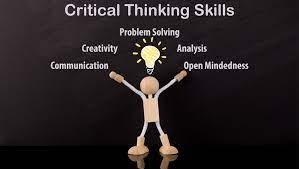Critical Thinking in workplace
The Power of Critical Thinking in the Workplace: Benefits and Characteristics
Critical thinking is a cornerstone skill in the workplace that enables objective and efficient problem-solving while reducing costly errors. Team members adept in critical thinking connect ideas, identify errors, and make well-informed decisions. Let's explore the crucial aspects of critical thinking, its benefits, and the characteristics that make it essential for workforce success.
Understanding Critical Thinking Skills
Critical thinking is a soft skill encompassing a range of interpersonal and analytical abilities. Here are key critical thinking skills that contribute to workplace excellence:
1. Observation: Critical thinkers possess keen observation skills, allowing them to detect and anticipate issues based on experience. They excel in seeing the bigger picture and embracing multiple perspectives.
2. Analytical Thinking: Analytical thinkers gather data from diverse sources, maintain objectivity, and ask probing questions. They meticulously collect facts, evaluate independent research, and sift through information to discern accuracy and relevance.
3. Open-Mindedness: Critical thinkers are open-minded individuals unafraid to consider differing opinions and information that challenge their beliefs. They can set aside personal biases to explore unexpected problem-solving avenues.
4. Problem-Solving Attitude: Critical thinkers actively seek optimal solutions to identified problems. They are proactive in offering recommendations based on a comprehensive analysis of available information.
5. Communication: Effective communication is a hallmark of critical thinkers. They excel in articulating their positions clearly, supported by compelling arguments and evidence. Sharing decisions with the team and stakeholders is a seamless process.
Benefits of Critical Thinking in the Workplace
Critical thinking training equips employees with the ability to make informed decisions by gathering essential information before acting. The advantages of fostering critical thinking in the workplace are manifold:
1. Reduced Errors: Hasty decisions and rushed actions often lead to costly mistakes. Critical thinking mitigates errors by encouraging thorough analysis before decision-making.
2. Improved Communication: Clear thinking enhances communication, allowing employees to express themselves effectively and contribute meaningfully to their roles.
3. Enhanced Emotional Intelligence: Critical thinkers prioritize rationality over impulsiveness, resulting in well-considered decisions that account for emotional and ethical dimensions.
4. Encouragement of Creativity: Open to new ideas and perspectives, critical thinkers accumulate diverse knowledge, fostering creativity and innovative problem-solving.
5. Time and Cost Savings: Critical thinking reduces the need for constant supervision, enables early problem detection, promotes independence and initiative, and allows managers to allocate their time more efficiently, ultimately saving company resources.
Characteristics of Successful Critical Thinking
Successful critical thinking is not an afterthought but an integral part of daily operations:
1. Crisis Management: Critical thinking shines during crises. For example, in a restaurant scenario, a server employing critical thinking skills can salvage a customer's negative experience by offering solutions like complimentary appetizers or discounts, preserving valuable customer relationships.
2. Leadership Influence: Leadership plays a pivotal role in shaping a company's behavior. Leaders who incorporate critical thinking processes garner team buy-in and lead their organizations to success. Effective communication often accompanies strong critical thinking skills.
Embrace the transformative power of critical thinking in your workplace. It's a skill that drives problem-solving excellence, enhances communication, and fosters a culture of innovation and informed decision-making.
What are Critical Thinking and Problem-Solving Skills?
In critical thinking, information is analysed, and rational decisions are made. Identifying the root cause of a problem and coming up with creative solutions involves looking at a situation from all angles. Taking action to solve a problem is called problem-solving. The process involves identifying the problem, brainstorming possible solutions, choosing the best action, and implementing it.



